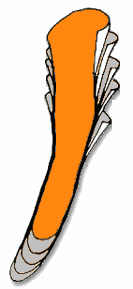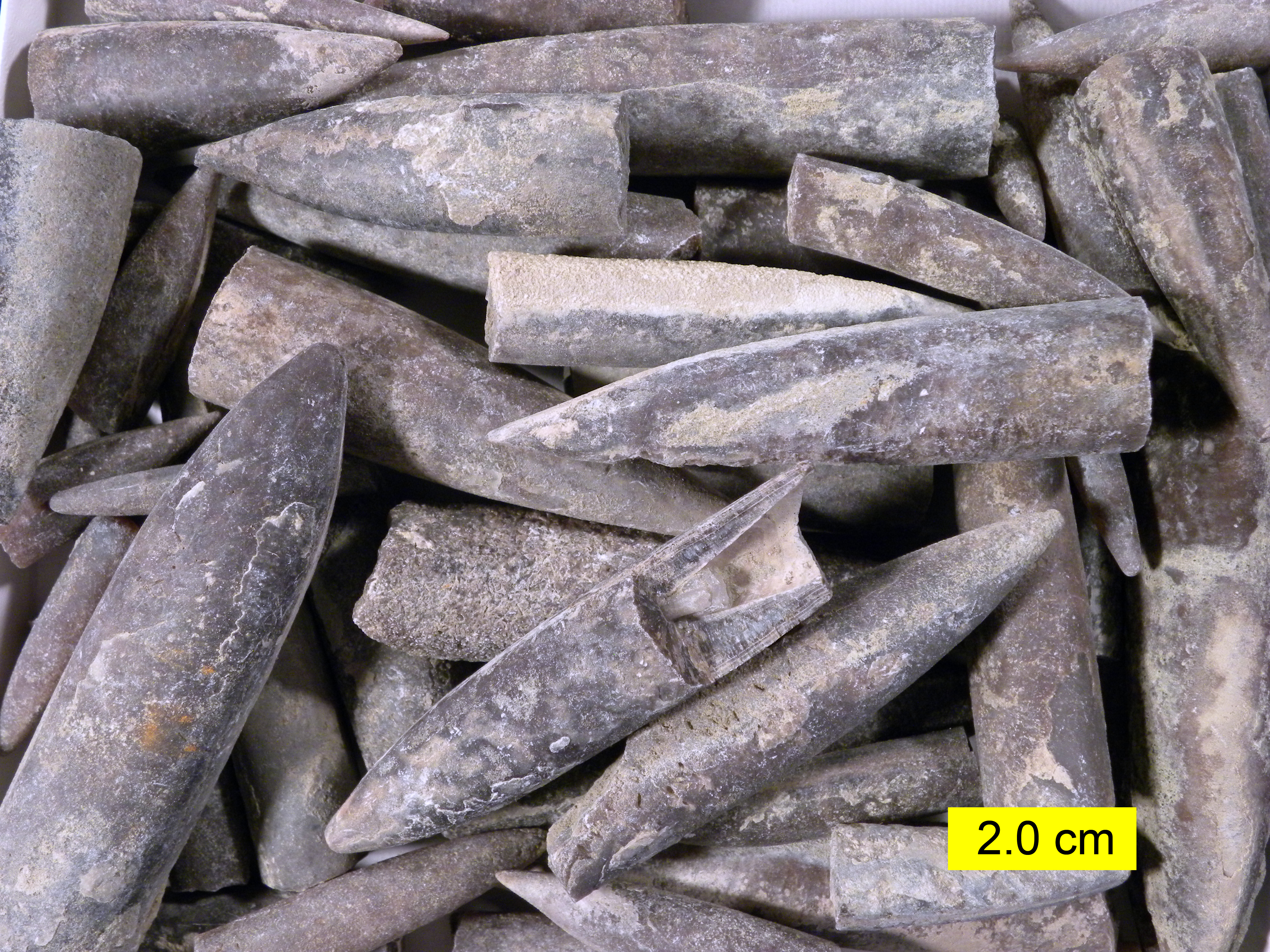|
Cloudinid
The cloudinids, an early metazoan family containing the genera ''Acuticocloudina'', ''Cloudina'' and ''Conotubus'', lived in the late Ediacaran period about 550 million years ago. and became extinct at the base of the Cambrian. They formed millimetre-scale conical fossils consisting of calcareous cones nested within one another; the appearance of the organism itself remains unknown. The name ''Cloudina'' honors the 20th-century geologist and paleontologist Preston Cloud. Cloudinids comprise two genera: ''Cloudina'' itself is mineralized, whereas ''Conotubus'' is at best weakly mineralized, whilst sharing the same "funnel-in-funnel" construction. Cloudinids had a wide geographic range, reflected in the present distribution of localities in which their fossils are found, and are an abundant component of some deposits. They never appear in the same layers as soft-bodied Ediacaran biota, but the fact that some sequences contain cloudinids and Ediacaran biota in alternating laye ... [...More Info...] [...Related Items...] OR: [Wikipedia] [Google] [Baidu] |
Metazoan
Animals are multicellular, eukaryotic organisms in the biological kingdom Animalia. With few exceptions, animals Heterotroph, consume organic material, Cellular respiration#Aerobic respiration, breathe oxygen, are Motility, able to move, can Sexual reproduction, reproduce sexually, and go through an ontogenetic stage in which their body consists of a hollow sphere of Cell (biology), cells, the blastula, during Embryogenesis, embryonic development. Over 1.5 million Extant taxon, living animal species have been Species description, described—of which around 1 million are Insecta, insects—but it has been estimated there are over 7 million animal species in total. Animals range in length from to . They have Ecology, complex interactions with each other and their environments, forming intricate food webs. The scientific study of animals is known as zoology. Most living animal species are in Bilateria, a clade whose members have a Symmetry in biology#Bilateral symmetry, bilat ... [...More Info...] [...Related Items...] OR: [Wikipedia] [Google] [Baidu] |
Nephrozoa
Nephrozoa is a major clade of bilaterians, divided into the protostomes and the deuterostomes, containing almost all animal phyla and over a million extant species. Its sister clade is the Xenacoelomorpha. The Ambulacraria (conventionally deuterostomes) was formerly thought to be sister to the Xenacoelomorpha, forming the Xenambulacraria as basal Deuterostomes, or basal Bilateria invalidating Nephrozoa and Deuterostomes in earlier studies. The coelom, the digestive tract and excretory organs (nephridia), and nerve cords developed in the Nephrozoa. It has been argued that, because protonephridia are only found in protostomes, they cannot be considered a synapomorphy of this group. This would make Nephrozoa an improper name, leaving Eubilateria as this clade's name. Chordates (which include all the vertebrates) are deuterostomes. It seems very likely that the ''Kimberella ''Kimberella'' is an extinct genus of bilaterian known only from rocks of the Ediacaran period. The s ... [...More Info...] [...Related Items...] OR: [Wikipedia] [Google] [Baidu] |
Annelid
The annelids (Annelida , from Latin ', "little ring"), also known as the segmented worms, are a large phylum, with over 22,000 extant species including ragworms, earthworms, and leeches. The species exist in and have adapted to various ecologies – some in marine environments as distinct as tidal zones and hydrothermal vents, others in fresh water, and yet others in moist terrestrial environments. The Annelids are bilaterally symmetrical, triploblastic, coelomate, invertebrate organisms. They also have parapodia for locomotion. Most textbooks still use the traditional division into polychaetes (almost all marine), oligochaetes (which include earthworms) and leech-like species. Cladistic research since 1997 has radically changed this scheme, viewing leeches as a sub-group of oligochaetes and oligochaetes as a sub-group of polychaetes. In addition, the Pogonophora, Echiura and Sipuncula, previously regarded as separate phyla, are now regarded as sub-groups of polycha ... [...More Info...] [...Related Items...] OR: [Wikipedia] [Google] [Baidu] |
Calcite
Calcite is a Carbonate minerals, carbonate mineral and the most stable Polymorphism (materials science), polymorph of calcium carbonate (CaCO3). It is a very common mineral, particularly as a component of limestone. Calcite defines hardness 3 on the Mohs scale of mineral hardness, based on Scratch hardness, scratch hardness comparison. Large calcite crystals are used in optical equipment, and limestone composed mostly of calcite has numerous uses. Other polymorphs of calcium carbonate are the minerals aragonite and vaterite. Aragonite will change to calcite over timescales of days or less at temperatures exceeding 300 °C, and vaterite is even less stable. Etymology Calcite is derived from the German ''Calcit'', a term from the 19th century that came from the Latin word for Lime (material), lime, ''calx'' (genitive calcis) with the suffix "-ite" used to name minerals. It is thus etymologically related to chalk. When applied by archaeology, archaeologists and stone trade pr ... [...More Info...] [...Related Items...] OR: [Wikipedia] [Google] [Baidu] |
Biodiversity
Biodiversity or biological diversity is the variety and variability of life on Earth. Biodiversity is a measure of variation at the genetic (''genetic variability''), species (''species diversity''), and ecosystem (''ecosystem diversity'') level. Biodiversity is not distributed evenly on Earth; it is usually greater in the tropics as a result of the warm climate and high primary productivity in the region near the equator. Tropical forest ecosystems cover less than 10% of earth's surface and contain about 90% of the world's species. Marine biodiversity is usually higher along coasts in the Western Pacific, where sea surface temperature is highest, and in the mid-latitudinal band in all oceans. There are latitudinal gradients in species diversity. Biodiversity generally tends to cluster in hotspots, and has been increasing through time, but will be likely to slow in the future as a primary result of deforestation. It encompasses the evolutionary, ecological, and cultural ... [...More Info...] [...Related Items...] OR: [Wikipedia] [Google] [Baidu] |
Cambrian Explosion
The Cambrian explosion, Cambrian radiation, Cambrian diversification, or the Biological Big Bang refers to an interval of time approximately in the Cambrian Period when practically all major animal phyla started appearing in the fossil record. It lasted for about 13 – 25 million years and resulted in the divergence of most modern metazoan phyla. The event was accompanied by major diversification in other groups of organisms as well. Before early Cambrian diversification, most organisms were relatively simple, composed of individual cells, or small multicellular organisms, occasionally organized into colonies. As the rate of diversification subsequently accelerated, the variety of life became much more complex, and began to resemble that of today. Almost all present-day animal phyla appeared during this period, including the earliest chordates. A 2019 paper suggests that the timing should be expanded back to include the late Ediacaran, rather than just the n ... [...More Info...] [...Related Items...] OR: [Wikipedia] [Google] [Baidu] |
Evolutionary Arms Race
In evolutionary biology, an evolutionary arms race is an ongoing struggle between competing sets of co-evolving genes, phenotypic and behavioral traits that develop escalating adaptations and counter-adaptations against each other, resembling an arms race. These are often described as examples of positive feedback.Dawkins, R. 1996. ''The Blind Watchmaker'' New York: W. W. Norton. Note: This book was also published by Penguin in 1991. While the text is identical, page numbers differ The co-evolving gene sets may be in different species, as in an evolutionary arms race between a predator species and its prey (Vermeij, 1987), or a parasite and its host. Alternatively, the arms race may be between members of the same species, as in the manipulation/sales resistance model of communication (Dawkins & Krebs, 1979) or as in runaway evolution or Red Queen effects. One example of an evolutionary arms race is in sexual conflict between the sexes, often described with the term Fisherian runa ... [...More Info...] [...Related Items...] OR: [Wikipedia] [Google] [Baidu] |
Sinotubulites
''Sinotubulites'' is a genus of small, tube-shaped shelly fossils from the Ediacaran period. It is often found in association with '' Cloudina''. Its tube has a "tube-in-tube" structure composed of several thin layers. It bears prominent longitudinal sculptures and / or irregular rings, which were formed by the wrinkles of tube layers, and weaken gradually towards the inner layers. The organism probably had a sessile life-style, lying on the sea floor. ''Sinotubulites'' and ''Cloudina'' (discovered in 1972) are currently the two earliest known fossils of organisms that mineralized shells when alive, and are often found in the same fossil beds. It is remarkable that ''Cloudina'' specimens often have tiny holes bored in them, which are attributed to predators, while no such borings have been found in ''Sinotubulites''. This suggests that ''Sinotubulites'' had evolved features that made it a much less attractive target than ''Cloudina''. As a result, both organisms are important i ... [...More Info...] [...Related Items...] OR: [Wikipedia] [Google] [Baidu] |
Skeleton
A skeleton is the structural frame that supports the body of an animal. There are several types of skeletons, including the exoskeleton, which is the stable outer shell of an organism, the endoskeleton, which forms the support structure inside the body, and the hydroskeleton, a flexible internal skeleton supported by fluid pressure. Vertebrates are animals with a vertebral column, and their skeletons are typically composed of bone and cartilage. Invertebrates are animals that lack a vertebral column. The skeletons of invertebrates vary, including hard exoskeleton shells, plated endoskeletons, or Sponge spicule, spicules. Cartilage is a rigid connective tissue that is found in the skeletal systems of vertebrates and invertebrates. Etymology The term ''skeleton'' comes . ''Sceleton'' is an archaic form of the word. Classification Skeletons can be defined by several attributes. Solid skeletons consist of hard substances, such as bone, cartilage, or cuticle. These can be further ... [...More Info...] [...Related Items...] OR: [Wikipedia] [Google] [Baidu] |
Mineralization (biology)
Biomineralization, also written biomineralisation, is the process by which living organisms produce minerals, often to harden or stiffen existing tissues. Such tissues are called mineralized tissues. It is an extremely widespread phenomenon; all six taxonomic kingdoms contain members that are able to form minerals, and over 60 different minerals have been identified in organisms. Examples include silicates in algae and diatoms, carbonates in invertebrates, and calcium phosphates and carbonates in vertebrates. These minerals often form structural features such as sea shells and the bone in mammals and birds. Organisms have been producing mineralized skeletons for the past 550 million years. Calcium carbonates and calcium phosphates are usually crystalline, but silica organisms (sponges, diatoms...) are always non crystalline minerals. Other examples include copper, iron and gold deposits involving bacteria. Biologically formed minerals often have special uses such as magneti ... [...More Info...] [...Related Items...] OR: [Wikipedia] [Google] [Baidu] |
Small Shelly Fossils
The small shelly fauna, small shelly fossils (SSF), or early skeletal fossils (ESF) are mineralized fossils, many only a few millimetres long, with a nearly continuous record from the latest stages of the Ediacaran to the end of the Early Cambrian Period. They are very diverse, and there is no formal definition of "small shelly fauna" or "small shelly fossils". Almost all are from earlier rocks than more familiar fossils such as trilobites. Since most SSFs were preserved by being covered quickly with phosphate and this method of preservation is mainly limited to the late Ediacaran and early Cambrian periods, the animals that made them may actually have arisen earlier and persisted after this time span. Some of the fossils represent the entire skeletons of small organisms, including the mysterious '' Cloudina'' and some snail-like molluscs. However, the bulk of the fossils are fragments or disarticulated remains of larger organisms, including sponges, molluscs, slug-like halki ... [...More Info...] [...Related Items...] OR: [Wikipedia] [Google] [Baidu] |







